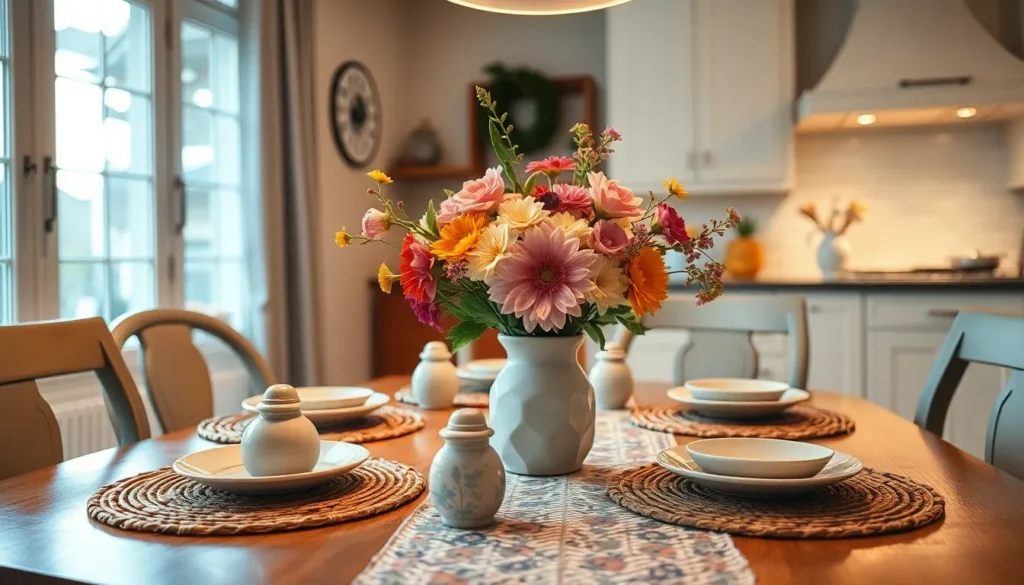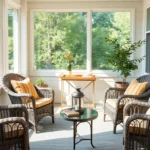We’ve all stood in our kitchens staring at that blank dining table wondering how to transform it from purely functional to absolutely stunning. Your kitchen table isn’t just where you eat—it’s the heart of your home where conversations flow and memories are made.
The right decor can completely revolutionize this central space without breaking your budget or requiring a complete redesign. Whether you’re hosting dinner parties or enjoying everyday family meals your table deserves to look as good as the food you’re serving on it.
We’re about to share the most effective strategies for creating beautiful kitchen table displays that work for any style budget or season. From simple centerpiece ideas to layered looks that wow your guests these proven techniques will help you design a table that becomes the focal point of your entire kitchen.
Choose the Perfect Centerpiece for Your Kitchen Table Decor
Selecting the right centerpiece creates a focal point that ties your entire kitchen table design together. We’ve found that the most effective centerpieces balance visual appeal with practical functionality for daily dining needs.
Fresh Floral Arrangements
Fresh flowers instantly elevate your kitchen table’s elegance while bringing natural beauty indoors. We recommend choosing blooms that complement your existing color scheme and maintain proportions that don’t obstruct conversation across the table.
Roses and peonies work beautifully for romantic settings, while sunflowers and daisies create cheerful, casual atmospheres. Tulips offer versatility throughout spring months, and eucalyptus branches provide year-round greenery with minimal maintenance requirements.
Consider vessel selection carefully when arranging fresh flowers. Mason jars suit farmhouse styles, while sleek glass vases complement modern kitchens. We suggest using odd numbers of stems for more natural-looking arrangements and trimming stems at varying heights to create visual interest.
Water changes every 2-3 days keep arrangements fresh longer, and adding flower food extends bloom life by up to a week. Placement away from direct sunlight prevents premature wilting while maintaining vibrant colors.
Seasonal Fruit Displays
Seasonal fruit displays combine visual appeal with practical accessibility, creating centerpieces that serve both decorative and functional purposes. We’ve discovered that fruit arrangements work particularly well in kitchen settings where family members frequently gather for meals and snacks.
Apples and pears create stunning autumn displays when arranged in wooden bowls or wicker baskets. Citrus fruits like oranges, lemons, and limes add vibrant pops of color during winter months while releasing pleasant natural fragrances.
Summer brings opportunities for colorful stone fruit arrangements featuring peaches, plums, and apricots. We recommend selecting fruits at similar ripeness levels to ensure consistent appearance throughout the display period.
Tiered serving stands maximize visual impact while saving table space. Ceramic bowls suit traditional kitchens, while metal wire baskets complement industrial designs. Regular rotation prevents over-ripening and maintains fresh appearances.
Candle Collections and Holders
Candle collections create warm, inviting atmospheres that transform ordinary meals into special occasions. We’ve found that strategic candle placement adds both ambient lighting and sophisticated elegance to kitchen table settings.
Pillar candles in varying heights create dramatic visual depth when grouped in clusters of three or five. Taper candles in elegant holders work beautifully for formal dining experiences, while tea lights scattered across the table surface provide subtle illumination for intimate gatherings.
Holder selection significantly impacts overall aesthetic appeal. Brass candlesticks complement traditional décor, while modern glass holders suit contemporary spaces. We suggest mixing textures and materials for added visual interest without overwhelming the table’s design.
Safety considerations remain paramount when using candles near dining areas. Ensure adequate clearance from overhead fixtures and never leave burning candles unattended. Battery-operated LED candles offer similar ambiance without fire risks, particularly beneficial for households with children or pets.
Select a Cohesive Color Scheme for Your Kitchen Table Decor
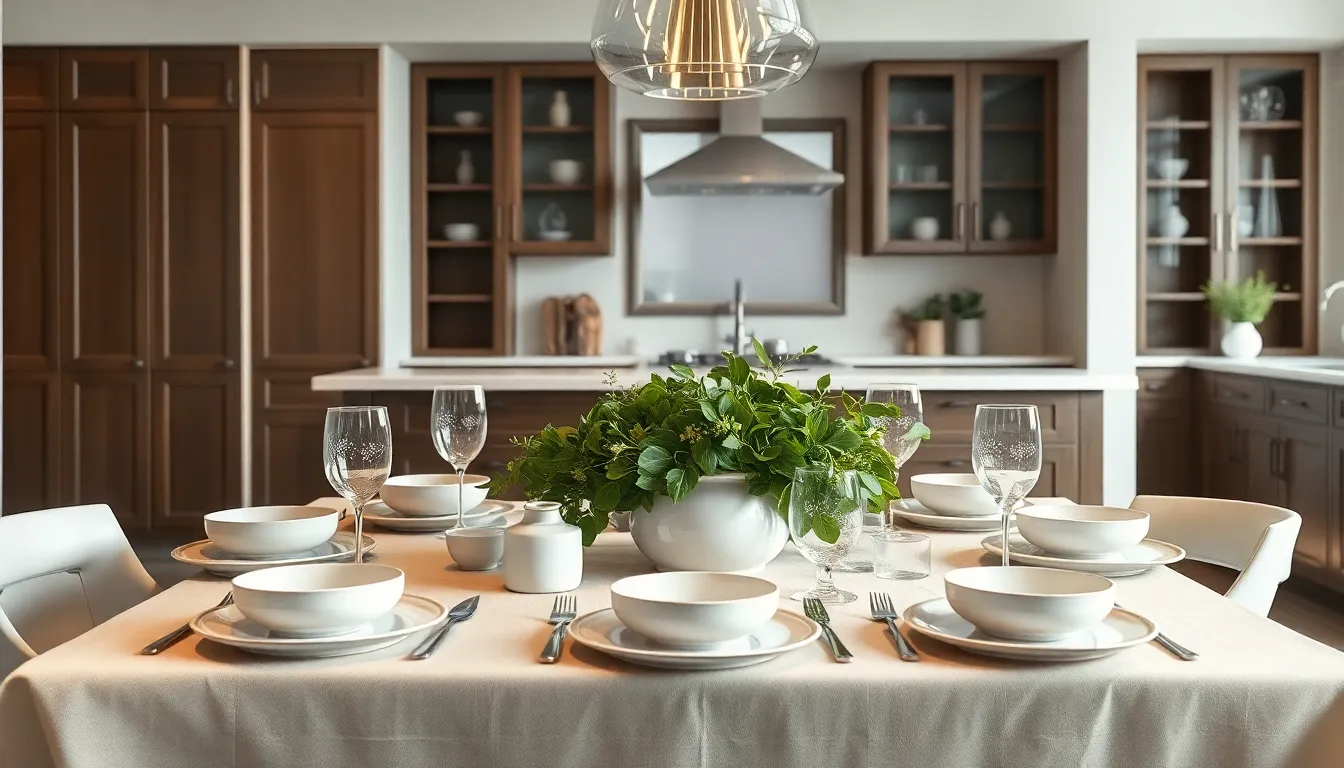
Color coordination transforms your table into a polished focal point that complements your kitchen’s overall design. We’ll explore three proven approaches that create stunning visual harmony while matching your personal style.
Neutral Tones for Timeless Appeal
White, gray, and beige create the foundation for sophisticated kitchen table decor that never goes out of style. These versatile shades provide a clean backdrop that complements most kitchen styles, from farmhouse to contemporary. We recommend starting with neutral linens like cream tablecloths or gray placemats to establish your base color.
Pairing neutral tones with various table settings becomes effortless since these colors work with almost any dinnerware or decorative elements. Beige table runners look stunning with both colorful ceramic plates and elegant white china. White centerpieces blend seamlessly with seasonal decorations throughout the year.
Building layers with different neutral textures adds visual interest without overwhelming your space. Natural linen napkins paired with ceramic serving dishes create depth while maintaining that timeless elegance we’re after.
Bold Colors for Modern Kitchens
Bright reds, blues, or greens inject energy into contemporary kitchen spaces through strategic color placement. These vibrant hues work best when incorporated through exact elements like table runners, placemats, or bold colored chairs rather than dominating the entire table setting.
Creating balance becomes crucial when working with bold colors to avoid overwhelming your dining space. We suggest using one bold color as your primary accent while keeping the majority of elements neutral. Red placemats paired with white dishes and gray napkins create striking contrast without visual chaos.
Incorporating bold colors through easily changeable accessories gives you flexibility to update your look seasonally. Bright blue table runners can transition from summer entertaining to winter holiday gatherings with simple swaps of complementary elements.
Seasonal Color Palettes
Spring and summer palettes featuring pastel shades, floral patterns, and light greens bring fresh energy to your kitchen table during warmer months. These soft colors create an airy, welcoming atmosphere perfect for casual brunches and outdoor inspired dining.
Fall transformations using warm tones like orange, yellow, and red capture the season’s cozy essence through rich tablecloths and autumn themed centerpieces. These colors pair beautifully with natural elements like pumpkins, pinecones, and seasonal foliage.
Winter styling with cool tones such as icy blues and whites creates an elegant, crisp aesthetic that complements holiday entertaining. Silver accents and white linens enhance these cool palettes while adding sophisticated sparkle to winter gatherings.
Applying seasonal color schemes through easily swappable elements like tablecloths, plates, and decorative accents allows you to refresh your table’s look four times per year without major investment.
Layer Different Textures to Enhance Your Kitchen Table Decor

Mixing various textures creates visual depth and transforms your kitchen table into a sophisticated focal point. We’ll explore three essential texture categories that work harmoniously together to elevate your table’s aesthetic appeal.
Natural Wood Elements
Wooden serving boards bring instant warmth and organic appeal to your table setting. We recommend using vintage wooden planks or modern cutting boards as striking centerpieces that double as functional serving pieces. Wooden backdrops create either rustic charm or refined elegance depending on your chosen style preference.
These natural elements ground your table design while providing a beautiful contrast to other materials. Reclaimed wood pieces add character and storytelling elements that guests always notice and appreciate.
Woven Placemats and Table Runners
Woven placemats introduce soft tactile elements that perfectly complement harder surfaces and create inviting place settings. We love how woven table runners add horizontal lines that guide the eye across your table while providing subtle texture variation.
Woven baskets serve dual purposes as both decorative elements and practical storage answers for fruits or small table accessories. These natural fiber pieces soften the overall look while maintaining functionality that busy families need.
Ceramic and Glass Accents
Terra cotta pots deliver earthy textures that pair beautifully with fresh plants or seasonal greenery displays. We find these ceramic elements add grounding weight that balances lighter decorative pieces throughout your arrangement.
Glass vases and containers reflect light to enhance your table’s overall ambiance while adding sophisticated shine. Tiered glass trays create vertical interest by allowing you to arrange decorative items at different heights for ever-changing visual appeal.
Combining these textural elements with fresh flowers or seasonal fruits creates inviting table settings that feel both polished and welcoming.
Incorporate Functional Decor Items Into Your Kitchen Table Setup
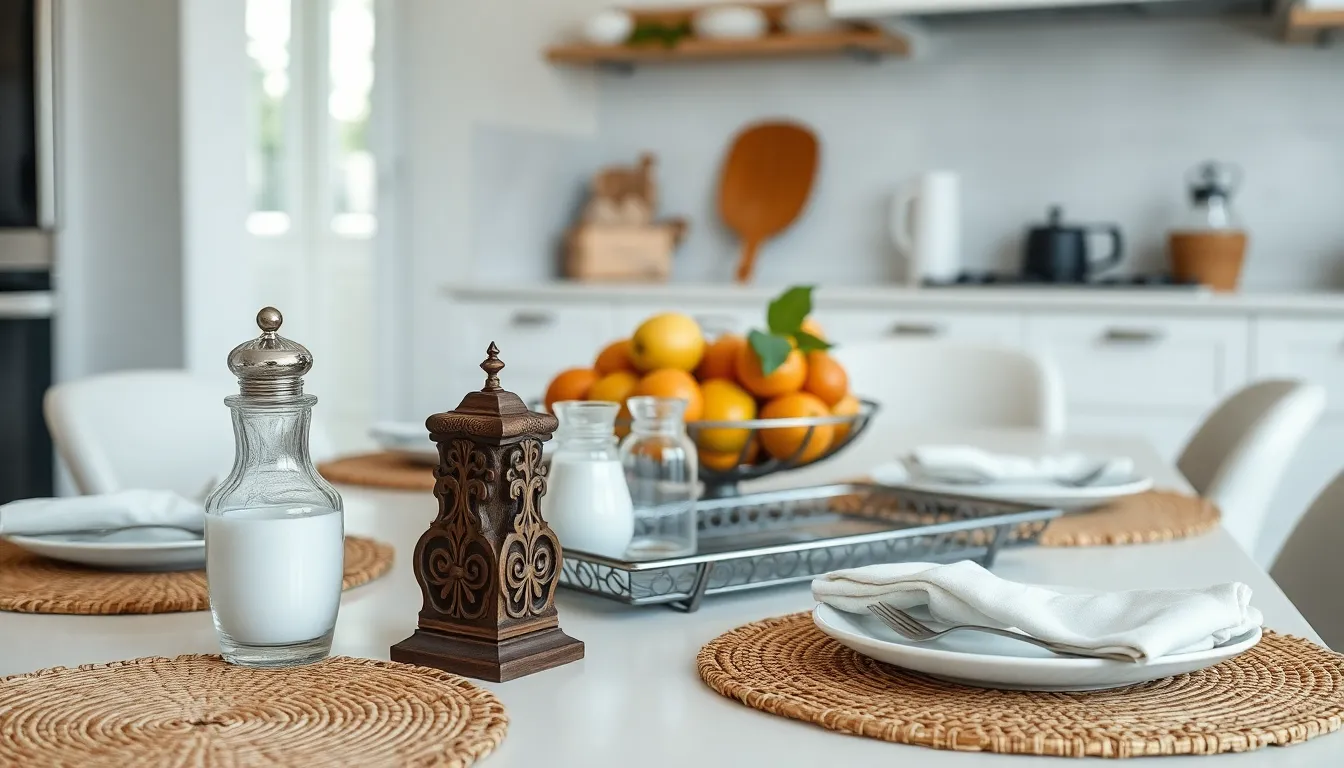
We believe the most successful kitchen table decor combines beauty with practicality. Functional items that serve daily needs while improving your table’s aesthetic create the perfect balance between style and utility.
Stylish Salt and Pepper Shakers
Salt and pepper shakers transform everyday dining into stylish experiences through thoughtful design choices. Modern minimalist designs work beautifully in contemporary kitchens, while ornate and decorative pieces add personality to traditional settings. Glass options provide transparency that blends seamlessly with any color scheme, while ceramic varieties offer endless pattern possibilities.
Wood materials bring natural warmth to your table setup, especially when paired with wooden serving boards or woven placemats. Metal designs create sophisticated statements through finishes like brushed steel, copper, or matte black. We’ve found these small accessories make important visual impact when they complement your existing texture layers.
Decorative Napkin Holders
Napkin holders keep your table organized while adding decorative elements that tie your entire setup together. Wooden holders complement natural texture themes perfectly, especially when featuring carved details or smooth modern lines. Metal options range from simple wire designs to elaborate artistic pieces that serve as conversation starters.
Woven fiber holders add softness to your table display while maintaining the practical benefit of napkin organization. We recommend choosing holders that match your placemat materials for cohesive styling. These functional pieces work particularly well when positioned near your centerpiece arrangements, creating balanced visual weight across the table surface.
Beautiful Serving Trays
Serving trays offer versatility that makes them essential for both daily use and special occasions. Wood varieties provide natural warmth while serving as platforms for displaying decorative items like candle collections or seasonal fruit arrangements. Glass trays reflect light beautifully, especially when paired with ceramic pots or other reflective elements.
Metal serving trays create statement pieces through materials like copper, brass, or stainless steel that complement modern kitchen aesthetics. We use trays to organize small kitchen essentials like salt shakers, napkin holders, and condiment containers into cohesive groupings. Elaborate designs work well as standalone decorative elements, while simple trays focus attention on the items they display.
Add Height and Dimension to Your Kitchen Table Decor
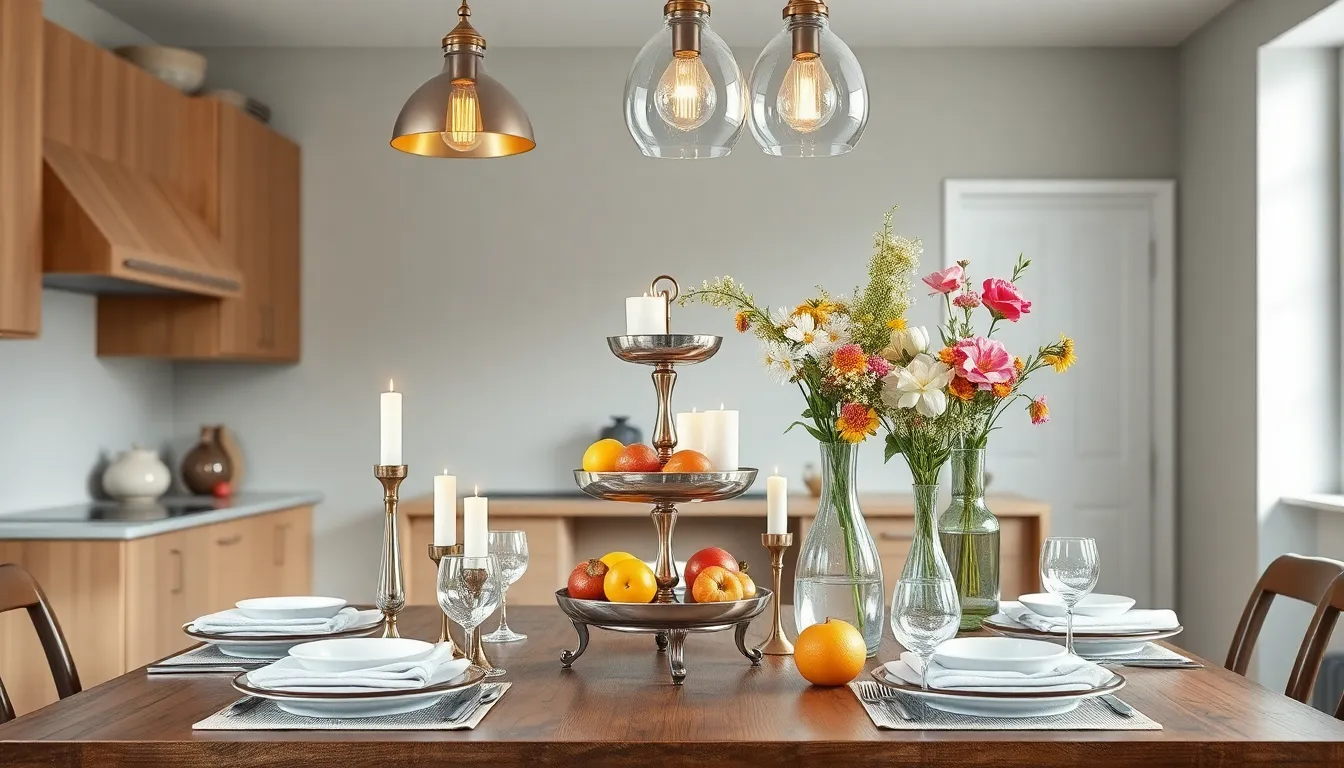
Creating visual depth transforms your kitchen table from flat to fabulous by drawing the eye upward and adding ever-changing appeal to your dining space.
Tiered Serving Stands
Tiered serving stands become your secret weapon for creating instant height while maximizing surface area for decorative displays. We love positioning these versatile pieces as centerpieces where they can showcase seasonal items like small potted herbs during spring or decorative ornaments during holidays. The multiple levels draw attention upward and create that coveted dimensional effect that makes your table feel more captivating and visually interesting.
Decorating each tier with different elements keeps the display from looking monotonous. Place candles on the top level, seasonal fruits on the middle tier, and small decorative dishes or napkin holders on the bottom level. This approach creates a cohesive yet varied look that gives your guests something interesting to admire from every angle.
Tall Vases and Containers
Tall vases work best when they measure about one third of your table’s total height to maintain proper proportions without blocking conversation. Standard dining tables measure 28 to 30 inches high, making vases around 9 to 10 inches tall the ideal choice for most kitchens. We recommend selecting vases with interesting shapes or textures that complement your existing decor style.
Filling these containers requires strategic thinking about both height and visual weight. Fresh flowers create natural elegance, while tall branches or dried botanicals offer year round appeal. Empty vases can also serve as sculptural elements that add sophistication without requiring constant maintenance or seasonal updates.
Hanging Elements Above the Table
Hanging elements like pendant lights or small chandeliers create overhead visual interest that complements your tabletop decor beautifully. The bottom of hanging fixtures should sit 30 to 36 inches above your table surface for standard 8 foot ceilings, with an additional 3 to 4 inches added for each extra foot of ceiling height. This positioning ensures adequate clearance while maximizing the lighting’s impact on your table setting.
We suggest choosing hanging elements that echo materials or colors already present in your table decor for a cohesive look. Metal fixtures pair wonderfully with ceramic serving pieces, while woven pendant shades complement natural wood elements and textured placemats perfectly.
Use Lighting to Create Ambiance in Your Kitchen Table Decor
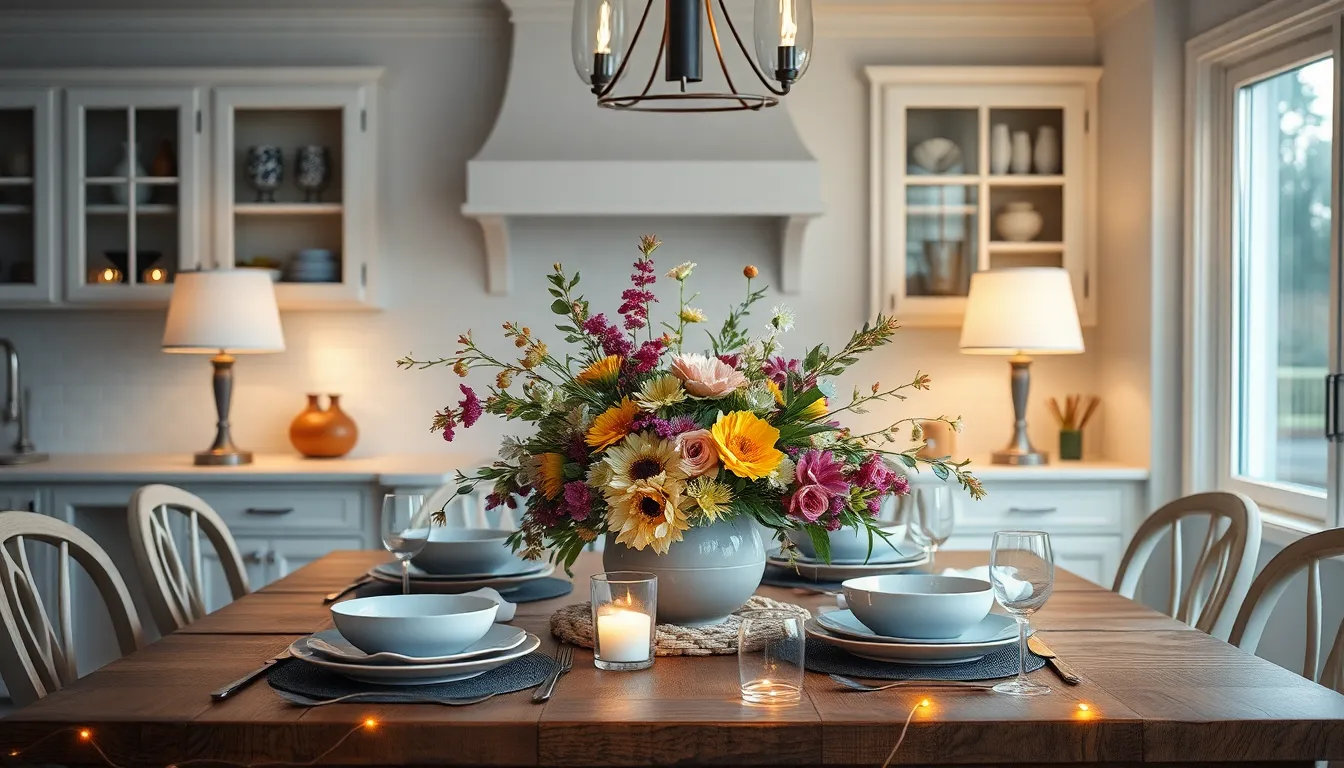
Lighting transforms your kitchen table into a welcoming gathering spot that perfectly complements your carefully chosen centerpieces and decor elements. We’ll explore three essential lighting approaches that enhance the ambiance while maintaining the functional beauty of your dining space.
Pendant Lights Over the Table
Pendant lights deliver focused illumination that creates warm and inviting ambiance directly above your kitchen table. We recommend hanging these fixtures 30-36 inches above the table surface to achieve optimal lighting without obstructing conversation flow.
Multiple pendant lights work exceptionally well for longer tables, creating a modern and sleek appearance that complements contemporary kitchen designs. Single large pendants add elegant sophistication to round or square tables while serving as stunning focal points themselves.
Consider materials that echo your existing table decor elements like wood grain finishes for rustic themes or metallic accents for industrial styles. Glass pendant shades diffuse light beautifully while ceramic options provide warmer, more intimate illumination.
Table Lamps for Cozy Dining
Table lamps bring versatile lighting answers that we can easily move and adjust based on your dining needs. These portable fixtures add cozy touches to kitchen table decor while providing additional illumination for reading menus or captivating in evening conversations.
Smaller kitchens particularly benefit from table lamp flexibility when overhead lighting feels limited or too harsh. We suggest placing battery operated table lamps on floating shelves nearby or directly on table corners during special occasions.
Choose lamp bases that coordinate with your ceramic and glass accent pieces to maintain visual cohesion across your table design. Fabric lampshades in neutral tones soften harsh lighting while colored shades can introduce seasonal elements that complement your rotating color schemes.
String Lights for Whimsical Touch
String lights introduce playful ambiance that makes kitchen table spaces feel relaxed and casual throughout the year. We can hang these versatile lights from ceiling fixtures, drape them around table perimeters, or wrap them around nearby furniture pieces.
Battery powered LED string lights offer the most flexibility since they don’t require electrical outlets and produce minimal heat. Warm white bulbs create cozy atmospheres while colored options support seasonal decor transitions from spring pastels to autumn warmth.
Consider combining string lights with your existing layered textures by weaving them through woven table runners or positioning them behind glass containers for enhanced reflection effects. This layered lighting approach works seamlessly with pendant lights and table lamps to create comprehensive ambiance that supports both intimate dinners and lively family gatherings.
Mix Vintage and Modern Elements in Your Kitchen Table Decor

Combining vintage charm with contemporary style creates a sophisticated table setting that feels both timeless and fresh. This approach allows you to showcase treasured pieces while maintaining a current aesthetic.
Antique Serving Pieces
Vintage china and glassware serve as elegant focal points when displayed alongside contemporary dinnerware sets. We recommend showcasing antique teacups, serving platters, or crystal glasses to create visual contrast and conversation starters. Antique cutlery like silverware or vintage knives adds character and sophistication to your table setting. These pieces bring history and craftsmanship that modern items often lack.
Antique serving bowls and cake stands provide perfect opportunities to display seasonal fruits or desserts while adding height variation to your arrangement. We suggest mixing different eras of vintage pieces rather than matching everything perfectly, as this creates more visual interest and authenticity.
Contemporary Dinnerware
Modern plates and bowls offer sleek, minimalist designs that beautifully complement ornate vintage pieces. We prefer choosing contemporary dinnerware in neutral colors like white, cream, or soft gray to let antique elements shine as statement pieces. Clean lines and simple shapes in modern dinnerware create breathing space around more decorative vintage items.
Ceramic or glass centerpieces in contemporary styles add pops of color and sophisticated form to your table arrangement. These modern elements prevent the overall look from feeling too nostalgic or dated while maintaining the elegant contrast you’re seeking.
Retro Inspired Accessories
Retro colors and patterns through vintage style placemats, tablecloths, or napkin rings inject playful energy into your kitchen table decor. We love incorporating bold geometric patterns from the 1960s or soft pastels from the 1950s to bridge the gap between true vintage and modern elements. These accessories are easily changeable, allowing you to experiment with different retro eras.
Lighting fixtures in retro styles or vintage inspired candles create nostalgic ambiance while serving practical purposes. Mixed chairs around your kitchen table add texture and visual interest, combining different decades of design for an eclectic yet cohesive look. Adding greenery through small potted plants or floral arrangements complements the vintage modern mix while bringing natural elements that soften the overall aesthetic.
Create Seasonal Themes for Your Kitchen Table Decor
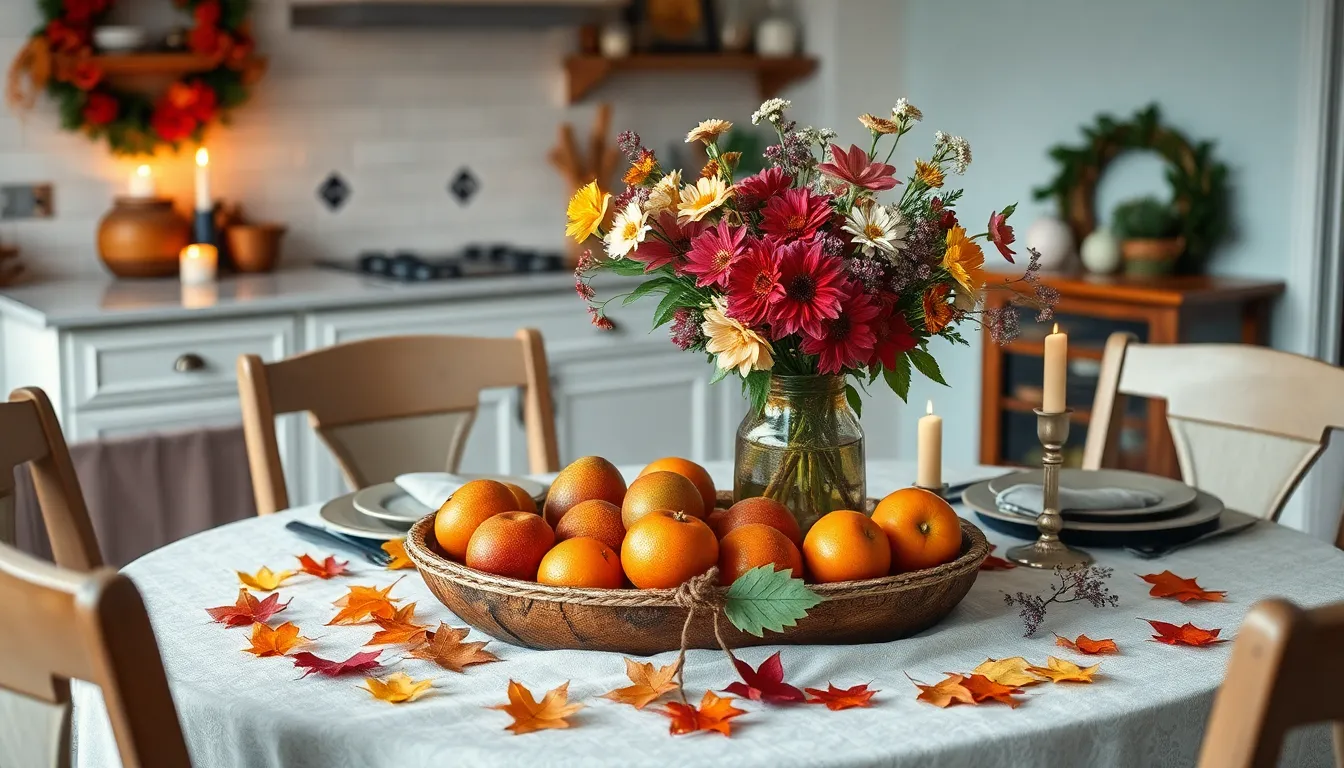
Seasonal themes allow us to refresh our kitchen table decor throughout the year while maintaining a cohesive design that reflects the natural beauty of each season. We can transform our dining space with simple adjustments that celebrate the changing seasons.
Spring and Summer Fresh Looks
Spring decor brings fresh energy to our kitchen tables through bright flowers, lush greenery, and soft pastel colors that create an cheerful atmosphere. We recommend using vases filled with spring flowers like tulips, daffodils, or cherry blossoms as centerpieces that instantly brighten the space. Natural elements such as branches, smooth pebbles, or small potted herbs add organic texture while maintaining the season’s fresh aesthetic.
Summer decorations embrace vibrant colors and light, airy textures that evoke warm weather and outdoor living. Citrus fruits like lemons, limes, and oranges serve as both decorative and functional elements when arranged in wooden bowls or glass containers. Seashells, coral pieces, or beach glass create a coastal vibe that pairs beautifully with white linens and blue accents. Fresh summer blooms such as sunflowers, roses, or hydrangeas bring the garden indoors while maintaining the season’s bright energy.
Fall Harvest Decorations
Fall harvest themes transform our kitchen tables into cozy gathering spaces using warm colors and natural autumn elements. Pumpkins in various sizes, gourds in different shapes, and colorful fall leaves create inviting displays that capture the season’s abundance. We suggest arranging these items in rustic wooden bowls or wicker baskets to enhance the harvest atmosphere.
Seasonal fruits like apples, pears, and pomegranates add both color and texture to fall centerpieces while providing healthy snacking options for family members. Cornucopias filled with autumnal items such as mini pumpkins, acorns, and dried corn create traditional focal points that celebrate the harvest season’s bounty.
Winter Holiday Styling
Winter holiday styling focuses on creating warm, inviting atmospheres using soft linens, flickering candles, and metallic accents in silver or gold. We recommend incorporating cozy textures like wool runners, faux fur placemats, or velvet napkins that add warmth during colder months. Candles in varying heights create intimate lighting that makes winter evenings more enjoyable.
Winter flowers such as white roses, amaryllis, or poinsettias provide elegant focal points when combined with evergreen branches or pine sprigs. Pinecones, holly berries, and small ornaments can be scattered around the centerpiece to add festive touches without overwhelming the table setting. Themed decorations like paper snowflakes, miniature Christmas trees, or menorah displays allow us to celebrate exact holidays while maintaining sophisticated table decor throughout the winter season.
Conclusion
Your kitchen table deserves to be more than just a place to eat – it’s the foundation for creating memorable moments with family and friends. We’ve shown you how simple changes like thoughtful centerpieces colorful schemes and layered textures can completely transform your space without very costly.
The key is finding the perfect balance between beauty and functionality while staying true to your personal style. Whether you prefer the timeless elegance of neutral tones or the bold energy of seasonal themes there’s a design approach that’ll work for your home.
Start with one element that speaks to you and build from there. Your kitchen table will become the welcoming centerpiece you’ve always wanted.
Frequently Asked Questions
What makes a good kitchen table centerpiece?
A good centerpiece serves as the focal point without overwhelming the space. Fresh floral arrangements offer natural elegance, while seasonal fruit displays provide both beauty and functionality. Candle collections create warm atmospheres perfect for dining. The key is choosing elements that complement your kitchen’s style while maintaining proper scale and proportion for conversation flow.
How do I choose the right color scheme for my kitchen table?
Start with one of three approaches: neutral tones (white, gray, beige) for timeless appeal, bold accent colors (reds, blues, greens) for modern kitchens, or seasonal palettes that change throughout the year. Ensure your chosen colors coordinate with existing kitchen elements and create visual harmony rather than competing with your space.
What textures work best for kitchen table decor?
Layer three essential texture categories: natural wood elements for warmth, woven placemats and runners for softness, and ceramic or glass accents for sophistication. Wooden serving boards add functionality, woven pieces provide practicality, while ceramic pots and glass containers reflect light beautifully, creating depth and visual interest.
How can I make my table decor both beautiful and functional?
Incorporate stylish functional items like decorative salt and pepper shakers, elegant napkin holders, and beautiful serving trays. These pieces serve daily needs while enhancing aesthetic appeal. Choose items that complement your color scheme and style, ensuring they’re both practical for everyday use and attractive enough to leave on display.
How do I add height and dimension to my table setting?
Use tiered serving stands as centerpieces to showcase seasonal items, incorporate tall vases that maintain proper proportions, and consider hanging elements like pendant lights positioned 30-36 inches above the table. These elements create visual depth without obstructing conversation, making your table setting more dynamic and interesting.
What lighting works best for kitchen table ambiance?
Combine three lighting approaches: pendant lights for focused illumination, table lamps for cozy warmth, and string lights for whimsical charm. Pendant lights should hang 30-36 inches above the table, while table lamps offer flexibility in smaller spaces. String lights add playful elements and integrate beautifully with existing decor.
How do I mix vintage and modern elements successfully?
Pair antique serving pieces with contemporary dinnerware to create visual contrast and conversation starters. Use vintage china and glassware alongside modern neutral plates, and incorporate retro-inspired accessories like unique placemats. Add greenery to soften the overall aesthetic and create cohesion between different style elements.
How often should I change my kitchen table decor?
Consider seasonal updates to keep your table fresh and relevant. Spring and summer call for bright flowers and vibrant colors, fall embraces warm hues and harvest elements, while winter focuses on cozy textures and festive decorations. However, you can also maintain a base design and simply swap accent pieces quarterly.

